Charts and Cards
Memfault charts allow you to proactively monitor any smart device, anywhere. Monitor your releases and view data-driven device and fleet-level metrics, like battery health, connectivity, and more in real-time dashboards.
Metric Charts
Memfault indexes and aggregates the metrics collected by your devices to provide you not only with insights of how individual devices are performing, but also the emergent behavior of your entire fleet.
You can add charts to visualize these aggregated, fleet-wide metrics by navigating to the sidebar and selecting Dashboards → Metrics.
Creating a new chart is as simple as clicking Create Chart, click
Create Metric chart from the dropdown menu selecting your metric of interest,
and choosing the desired aggregation type. Note that only metrics
configured as Timeseries can be used in
Metric Charts.
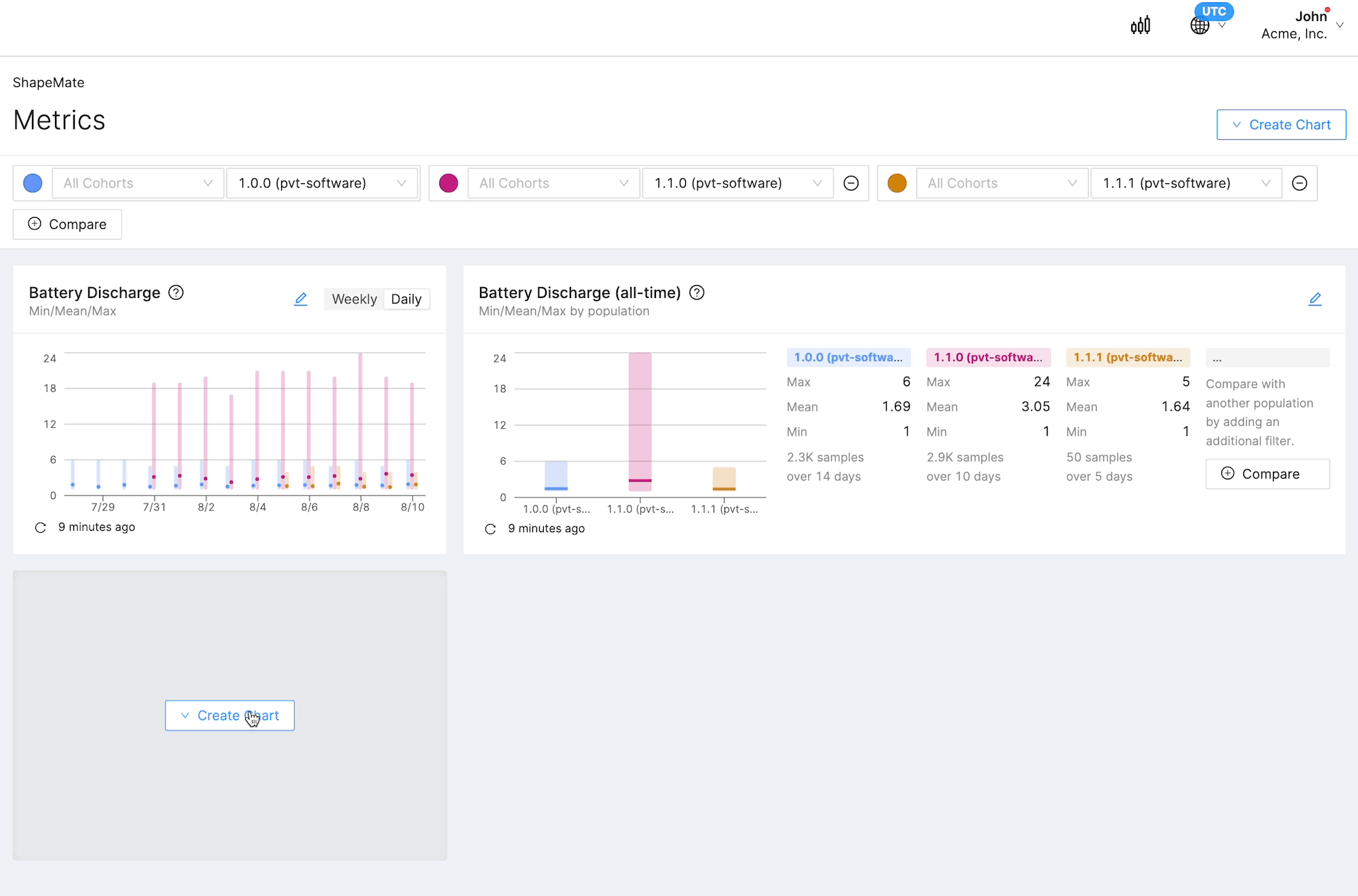
The list of metrics available in your project is automatically created from the metrics collected by your devices. For that reason, at least one device must upload data for a given metric before a chart for that metric can be created.
| Aggregation | Description |
|---|---|
| Min | The lowest reading received. |
| Mean | Arithmetic mean of all readings. |
| Max | The highest reading received. |
| Min/Mean/Max | All of the above combined into a single chart. |
| Percentiles | Distribution of values. |
| Count | Number of times a value was received. |
| Sum | Sum of all readings. |
For more information about adding metrics to your devices:
- Bare Metal/RTOS: see the Metrics Guide
- Android: update to the 3.0+ version of the Bort SDK
- Linux: see the Metrics Guide
Metric Charts by Cohort or Software Version
The metric charts in our system offer more than just time-based analysis; they can also be created based on aggregations by Software Version or Cohort. This added flexibility enables the comparison of metrics among specific population groups, making it a powerful tool for targeted analysis. By utilizing this chart, you gain the ability to examine a specific metric for a particular population across all time, providing a comprehensive view that uncovers valuable insights into long-term trends and patterns.
Please note that this particular type of chart only supports the Min/Mean/Max, and percentiles aggregation methods. The percentiles chart is limited to 3 months of data.
To create a Metric Chart by Population, select Rollup → By Cohort or Software Version while creating the chart.
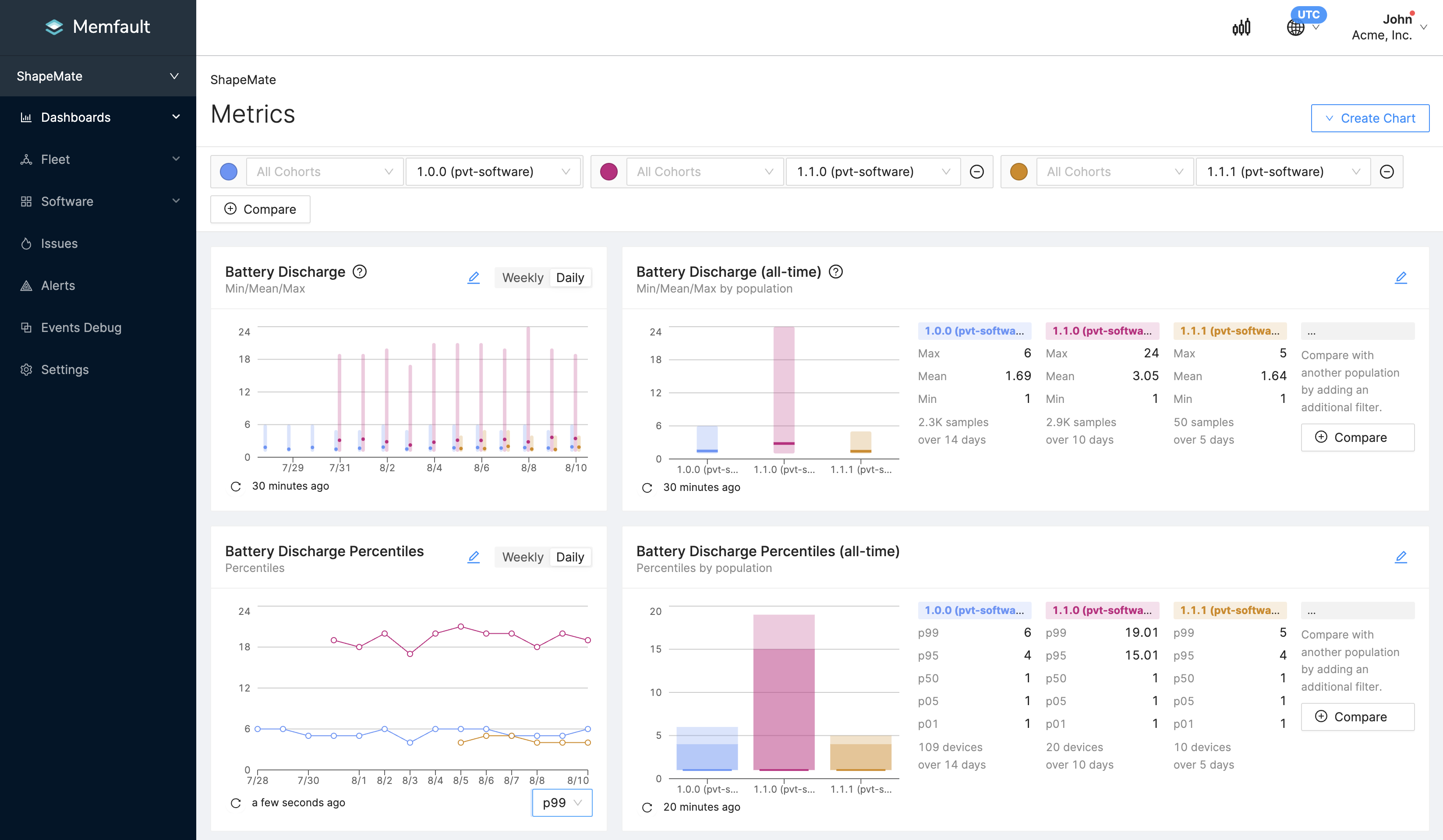
Issue Charts
Issue Charts allow you to visualize issues and traces in a variety of ways.
Trace Count Over Time
This shows the number of times a problem occurred over the past days, weeks. This chart can be focused to a single issue, or set of issues to allow you to monitor the impact of a specific problem.
Issue Count Over Time
Traces show an individual occurrence of a problem, whereas issues are groups of traces. This chart visualizes the latest occurrence of an item from those groups. Trace counts are useful for seeing the prominence of problem, while issue counts are useful for viewing if there are multiple types of a problems in your fleet.
Top 5 Issues
Top 5 issues charts allow you to view a table of issues sorted by count of number of traces, number of affected devices, first seen or last seen date of the issue. This rollup is beneficial for identifying what are your oldest, most recent, and biggest impact issues.
For more information on the differences between issues and traces we recommend reading What is an issue?.
Reboots and Crashes Charts
The built-in Reboot Reasons and Crashes per 10,000 Hours charts are a great way of comparing the stability of different software versions, or over time.
Reboot Reasons
The Reboot Reasons chart can be used to compare the relative occurrence of all reboots or specific types of reboots across different software versions.
Use the toggle in the top right or hover over the tooltip to see the absolute data.

Crashes per 10,000 Hours
This chart is only available for MCU devices.
The Crashes per 10,000 Hours chart is another way to compare the stability of software versions.

Due to the normalization over operating hours, data is only shown once there are at least 5,000 operating hours in total for each compared software version or versions. You will see an "insufficient operating hours" message if there are too few operating hours.
The operating hours are calculated based on the Memfault SDK's
MemfaultSdkMetric_IntervalMs value, and the total number of crashes is
calculated using the UnexpectedRebootCount metric. These are automatically
collected in every heartbeat. In order to adjust for reboot loops, only a
single unexpected reboot is considered per heartbeat interval.
Any MfltResetReason which is Unknown or >= UnknownError is considered an
unexpected reboot.
loading...
Device Vitals Cards
The built-in Device Vitals Cards show various insights based on core metrics collected by the Memfault SDKs. These cards allow you to quickly understand how the average device in your fleet is performing, using three device health concepts that are applicable to a wide range of devices.
These cards can also be filtered by software version(s) to compare device health between different releases.
To add a Device Vitals Card, click the Create Chart button in the top-right
corner of a dashboard page and select the relevant option:
- Create Stable Hours card
- Create Sync Success % card
- Create Connected Time % card
- Create Expected Battery Life card
Stable Hours
The Stable Hours card shows how much of the device's operational time is spent crash-free.

Connectivity
The Connectivity cards show how well the median device in your fleet stays connected, whether your devices perform discrete data sync operations or maintain continuous connections.
Sync Success % (Periodic Connectivity)
The Sync Success % card shows how often a data sync operation succeeds.

Connected Time % (Always-On Connectivity)
The Connected Time % card shows how much of the expected uptime is spent connected.
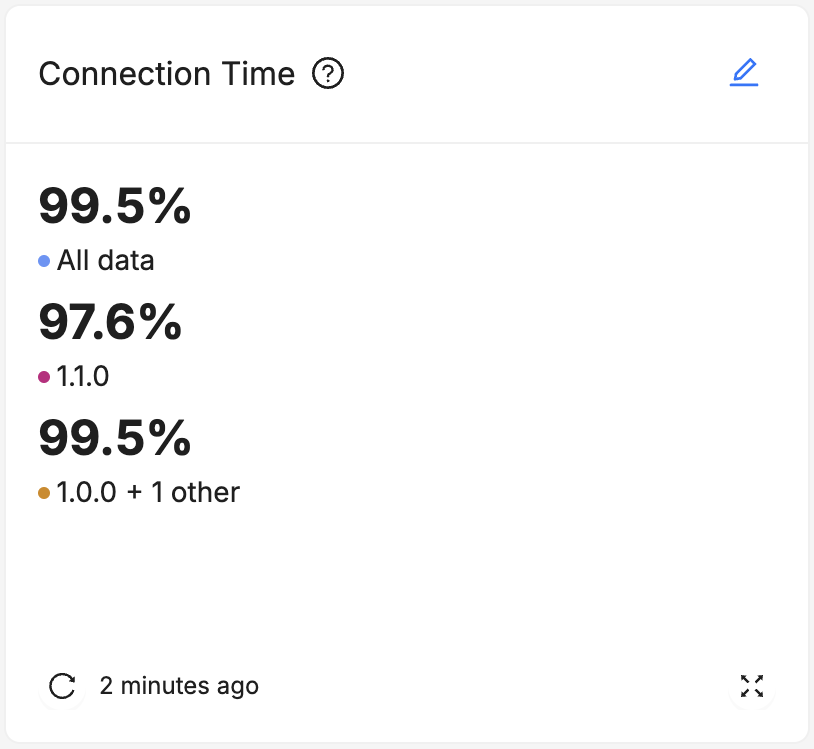
Expected Battery Life
The Expected Battery Life card shows how long the battery is expected to last for the median device.

Device Vital Drilldowns
To view what devices are represented in specific ranges of the Device Vital Percentile chart, click on the section to "drill down" into it. When you drill down to a range from the chart, you will be navigated to a pre-filtered Device Search page.

On the Device Search page you can see the specific devices and their aggregated value of the selected device vital. From here you can navigate to a specific device, or adjust filters to further refine and narrow your search.
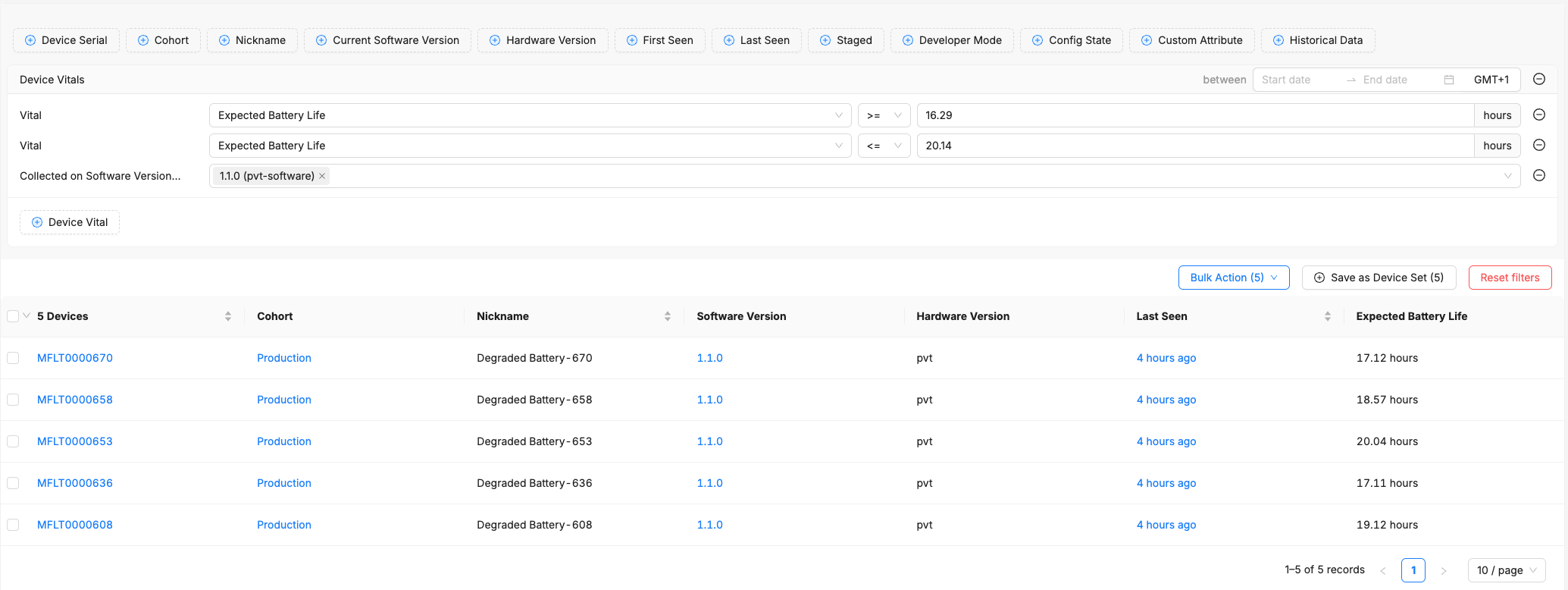
Active Devices Chart
Active devices Chart shows the number of active devices in your fleet over time. This chart is useful for tracking the growth of your fleet and can be used to identify trends.
- Pending devices have been created in Memfault but have not yet contacted Memfault.
- Active devices have contacted Memfault on the given week.
- Inactive devices have previously contacted Memfault, but not on the given week.

Software Versions Chart
The Software Versions chart shows the distribution of software versions across your fleet. This chart has 2 modes:
- Current
- Over Time
While the Current gives you a deeper look into the distribution of software versions in your fleet at this moment, the Over Time mode allows you to track the evolution of the distribution of software versions over time. This chart is useful for tracking the adoption of new software versions and can be used to identify trends.

Device Alert Incidents Chart
The Device Alert Incidents chart shows the number of device alerts that have occurred in your fleet over time. This chart is a good way to track number of incidents.
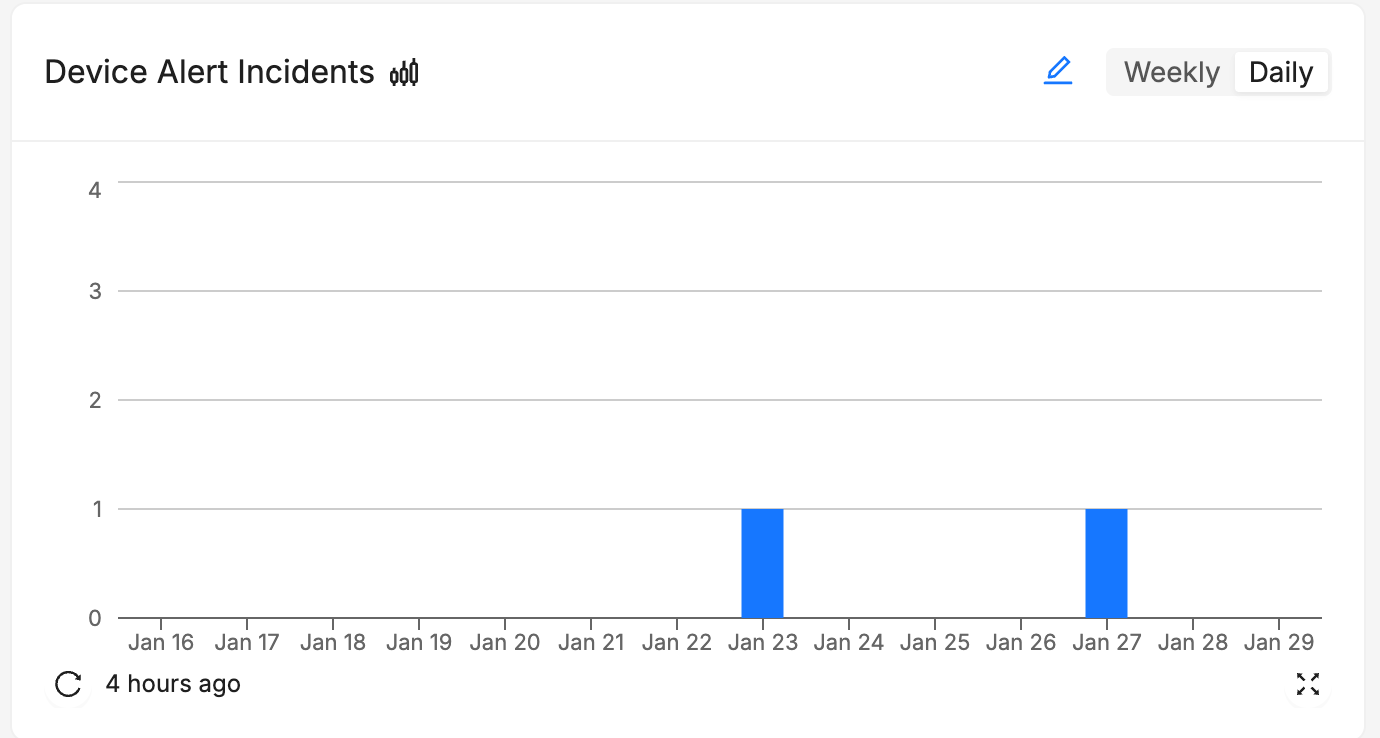
Received Bug Reports Chart
This chart is only available for Android devices.
::: The Received Bug Reports chart shows the number of bug reports that have been received by Memfault over time. This chart does not have any other configuration options.
Markdown Cards
You can add Markdown Cards to your dashboard to add context to your charts and
dashboards. To add a Markdown Card, click the Create Chart button in the
top-right corner of the page and select Create Markdown Card. These cards
support full markdown syntax and can be used to add text, images, and links to
your dashboard.
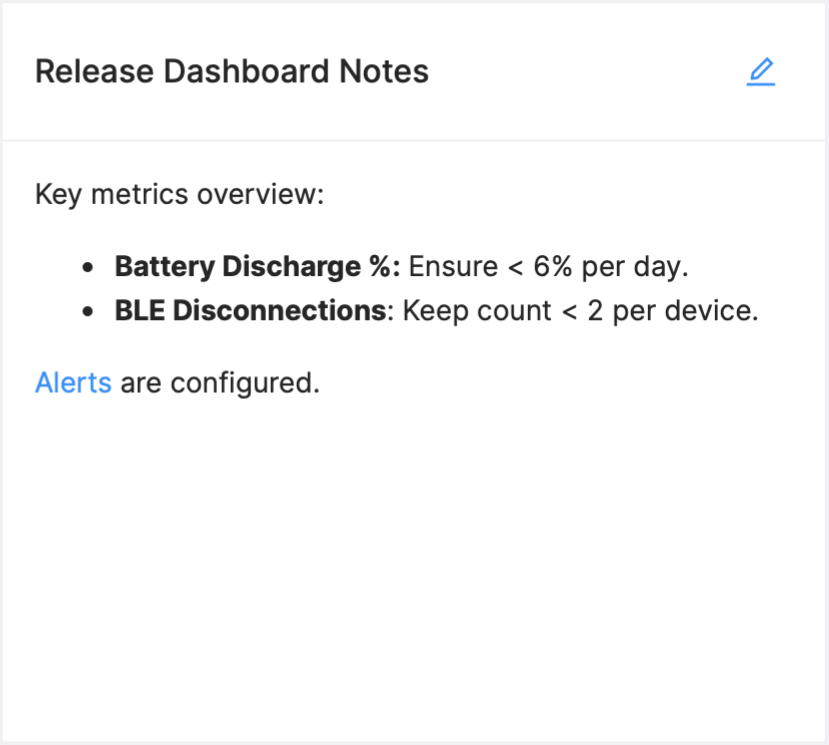
Device Sets
It is often useful to search for devices that fulfill certain criteria and to keep track of the number of matches over time. Examples of this could be searching for devices that:
- have not communicated with Memfault within the last N days,
- are running a deprecated software version, or
- are reporting a metric over a critical threshold.
This kind of follow-up can easily be done by defining a Device Set, which will do a daily tally of a search query of your choice, and present it to you in a graph:
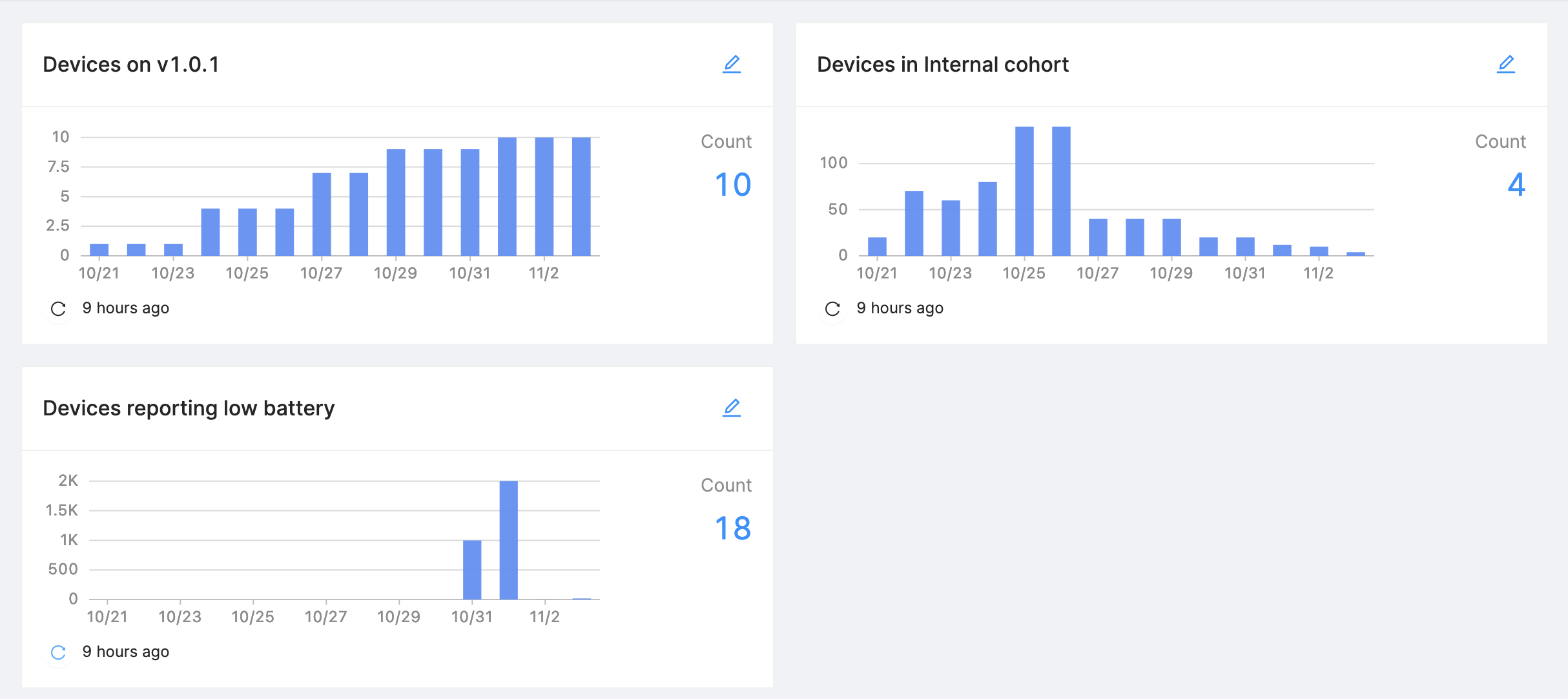
As soon as the Device Set is defined, Memfault starts collecting daily tallies. We store daily tallies for up to 14 days.
Device Sets are not just pretty graphs, you can also get a listing of the Devices belonging to the Device Set, for further analysis.
Device Sets are great for getting concrete answers to fleet-wide questions. As with Cohorts, they are also a great way of categorizing your Fleet, albeit with more flexibility: a Device can be a member of any number of Device Sets.
Creating a Device Set
Device Sets are created from the Devices page. Perform a search, click on the Save as Device Set button, give the Device Set a name (and optional description), select a dashboard you want to put this in, and you are done! You can view your newly created Device Set on the Dashboard you selected.
Depending on the query, it may take up to a day for the first data to trickle in.
Viewing the Devices currently in a Device Set
Clicking the latest count for a Set will take you to the Devices page, with the appropriate search terms filled in.
Interpreting Device Set data
The daily tally corresponds to running the same search query on the Devices page once per day, at roughly the same time. This provides an excellent large-scale overview of whatever properties of your fleet you may be interested in, but you shouldn't rely on the exact number, since the tallying time may vary slightly from day to day.
When using any time-related criteria to describe a device set (for example, "Last Seen" or "Historical Data" filters), the "Start date" and "End date" values are stored into the Device Set as relative to the time of the query, as depicted below:

Editing/deleting a Device Set
You can edit the name and the description of the Device Set by clicking the edit button. Editing the search query itself is disabled to preserve comparability with historical data, if you need to change the query, create a new Device Set.
You can of course also delete a Device Set that no longer interests you.